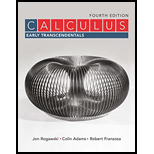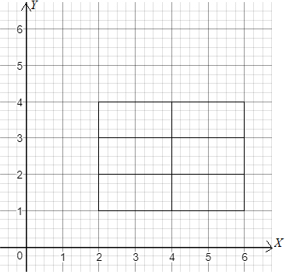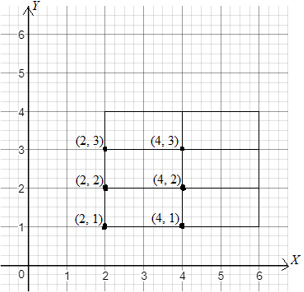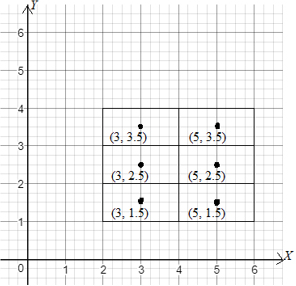
Calculate the Riemann sum for the given
a) Lower-left vertex
b) Midpoint of rectangle
Then calculate the exact value of the double integral.
Answer to Problem 1CRE
Solution:
(a) The Riemann sum for the given double integral using lower-left vertices is 240.
(b)The Riemann sum for the given double integral using midpoints is 510.
And the exact value of the double integral is 520.
Explanation of Solution
Given:
The integral:
Formulas:
Where
Calculations:
From the given integral, we can observe that and . Since our aim is to find , we need to divide the rectangle into subrectangles. The length and width of each subrectangle are calculated as follows:
Therefore, the area of each subrectangle is .
The subrectangles are shown in Image 1.
Image 1:

(a) Using Lower-left vertex
Here, we use the lower-left vertices of each subrectangleto find the Riemann sum . Notice that the lower-left vertices are and are shown in Image 2.
Image 2:

Thus,
(b) Using Midpoint of Rectangle:
Here, we use the midpoints of each subrectangle to find the Riemann sum . Notice that the midpoints are and are shown in Image 3.
Image 3:

Thus,
To calculate the exact value of the integral:
Conclusion:
Thus,
(a) The Riemann sum for the given double integral using lower-left vertices is 240.
(b)The Riemann sum for the given double integral using midpoints is 510.
And the exact value of the double integral is 520.
Want to see more full solutions like this?
Chapter 15 Solutions
CALCULUS:EARLY TRANS.(LL)-W/ACCESS
- A 20 foot ladder rests on level ground; its head (top) is against a vertical wall. The bottom of the ladder begins by being 12 feet from the wall but begins moving away at the rate of 0.1 feet per second. At what rate is the top of the ladder slipping down the wall? You may use a calculator.arrow_forwardExplain the focus and reasons for establishment of 12.4.1(root test) and 12.4.2(ratio test)arrow_forwarduse Integration by Parts to derive 12.6.1arrow_forward
- Explain the relationship between 12.3.6, (case A of 12.3.6) and 12.3.7arrow_forwardExplain the key points and reasons for the establishment of 12.3.2(integral Test)arrow_forwardUse 12.4.2 to determine whether the infinite series on the right side of equation 12.6.5, 12.6.6 and 12.6.7 converges for every real number x.arrow_forward
- use Corollary 12.6.2 and 12.6.3 to derive 12.6.4,12.6.5, 12.6.6 and 12.6.7arrow_forwardExplain the focus and reasons for establishment of 12.5.1(lim(n->infinite) and sigma of k=0 to n)arrow_forwardExplain the focus and reasons for establishment of 12.5.3 about alternating series. and explain the reason why (sigma k=1 to infinite)(-1)k+1/k = 1/1 - 1/2 + 1/3 - 1/4 + .... converges.arrow_forward
 Calculus: Early TranscendentalsCalculusISBN:9781285741550Author:James StewartPublisher:Cengage Learning
Calculus: Early TranscendentalsCalculusISBN:9781285741550Author:James StewartPublisher:Cengage Learning Thomas' Calculus (14th Edition)CalculusISBN:9780134438986Author:Joel R. Hass, Christopher E. Heil, Maurice D. WeirPublisher:PEARSON
Thomas' Calculus (14th Edition)CalculusISBN:9780134438986Author:Joel R. Hass, Christopher E. Heil, Maurice D. WeirPublisher:PEARSON Calculus: Early Transcendentals (3rd Edition)CalculusISBN:9780134763644Author:William L. Briggs, Lyle Cochran, Bernard Gillett, Eric SchulzPublisher:PEARSON
Calculus: Early Transcendentals (3rd Edition)CalculusISBN:9780134763644Author:William L. Briggs, Lyle Cochran, Bernard Gillett, Eric SchulzPublisher:PEARSON Calculus: Early TranscendentalsCalculusISBN:9781319050740Author:Jon Rogawski, Colin Adams, Robert FranzosaPublisher:W. H. Freeman
Calculus: Early TranscendentalsCalculusISBN:9781319050740Author:Jon Rogawski, Colin Adams, Robert FranzosaPublisher:W. H. Freeman
 Calculus: Early Transcendental FunctionsCalculusISBN:9781337552516Author:Ron Larson, Bruce H. EdwardsPublisher:Cengage Learning
Calculus: Early Transcendental FunctionsCalculusISBN:9781337552516Author:Ron Larson, Bruce H. EdwardsPublisher:Cengage Learning





